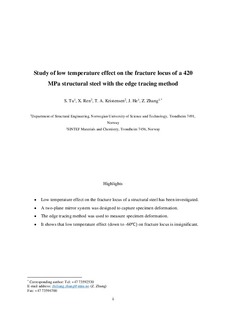| dc.contributor.author | Tu, Shengwen | |
| dc.contributor.author | Ren, Xiaobo | |
| dc.contributor.author | Kristensen, Tore Andre | |
| dc.contributor.author | He, Jianying | |
| dc.contributor.author | Zhang, Zhiliang | |
| dc.date.accessioned | 2018-12-14T08:57:05Z | |
| dc.date.available | 2018-12-14T08:57:05Z | |
| dc.date.created | 2018-03-08T12:28:16Z | |
| dc.date.issued | 2018 | |
| dc.identifier.citation | Fatigue & Fracture of Engineering Materials & Structures. 2018, 41 (8), 1649-1661. | nb_NO |
| dc.identifier.issn | 8756-758X | |
| dc.identifier.uri | http://hdl.handle.net/11250/2577677 | |
| dc.description.abstract | Quasi-static tensile tests with smooth round bar and axisymmetric notched tensile specimens have been performed to study the low-temperature effect on the fracture locus of a 420-MPa structural steel. Combined with a digital high-speed camera and a 2-plane mirror system, specimen deformation was recorded in 2 orthogonal planes. Pictures taken were then analysed with the edge tracing method to calculate the minimum cross-section diameter reduction of the necked/notched specimen. Obvious temperature effect was observed on the load-strain curves for smooth and notched specimens. Both the strength and strain hardening characterized by the strain at maximum load increase with temperature decrease down to −60°C. Somewhat unexpected, the fracture strains (ductility) of both smooth and notched specimens at temperatures down to −60°C do not deteriorate, compared with those at room temperature. Combined with numerical analyses, it shows that the effect of low temperatures (down to −60°C) on fracture locus is insignificant. These findings shed new light on material selection for Arctic operation. | nb_NO |
| dc.language.iso | eng | nb_NO |
| dc.publisher | Wiley | nb_NO |
| dc.title | Study of low-temperature effect on the fracture locus of a 420-MPa structural steel with the edge tracing method | nb_NO |
| dc.title.alternative | Study of low-temperature effect on the fracture locus of a 420-MPa structural steel with the edge tracing method | nb_NO |
| dc.type | Journal article | nb_NO |
| dc.description.version | submittedVersion | nb_NO |
| dc.source.pagenumber | 1649-1661 | nb_NO |
| dc.source.volume | 41 | nb_NO |
| dc.source.journal | Fatigue & Fracture of Engineering Materials & Structures | nb_NO |
| dc.source.issue | 8 | nb_NO |
| dc.identifier.doi | 10.1111/ffe.12803 | |
| dc.identifier.cristin | 1571414 | |
| dc.relation.project | Norges forskningsråd: 228513 | nb_NO |
| dc.description.localcode | This is the pre-peer reviewed version of an article, which has been published in final form at [https://doi.org/10.1111/ffe.12803]. This article may be used for non-commercial purposes in accordance with Wiley Terms and Conditions for Self-Archiving. | nb_NO |
| cristin.unitcode | 194,64,45,0 | |
| cristin.unitname | Institutt for konstruksjonsteknikk | |
| cristin.ispublished | true | |
| cristin.fulltext | preprint | |
| cristin.qualitycode | 2 | |
